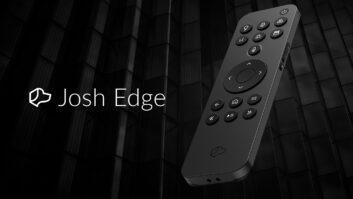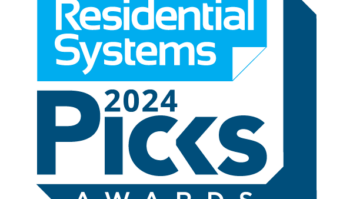Hard drive content management has the clamor of any burgeoning technology category. But unlike just any new product line, the hard drive systems genre might alter existing notions of home audio, with its relatively mammoth storage capabilities and symbiosis with home networking.
The Consumer Electronics Show, which assembled in Las Vegas last month, lifted the curtain on this growing industry, with new product roll outs and a doubling of OEMs offering music recognition functionality. Content delivery platforms including OpenGlobe, XiVa, ZapMedia, Perception Digital and AudioRamp serve as the backbone of new hard drive entertainment systems. These platforms offer digital media management, recording, organizing and myriad storage functions. ReQuest Multimedia, Escient, Lansonic, Pioneer, Compaq, JVC, Marantz, Onkyo, SonicBLUE, Moxi and Kenwood round out the manufacturers incorporating hard disc media management in their new product offerings.
The Databases
Meta-data is the term now used to describe the information about information, i.e., facts about music files. Meta-data is the key to the music recognition technology kings, Gracenote and freedb. Escient purchased the Gracenote CDDB (compact disc database) in 1998, and since then has been beefing its capabilities and ensuring the legality of its endeavors. Gracenote is music recognition technology that enables pertinent information and services to enhance the music experience. The Gracenote experience works like this: once a user inserts a CD into his or her Gracenote-enabled component, the music-recognition technology searches its behemoth database and retrieves information about the specific artist, track, the album and production information. It will then display any available cover art, list touring dates and etc. Essentially, the need for manual data entry is eliminated.
Apparently swooned by Gracenote’s capabilities, Thomson Multimedia has decided to enter the digital media management arena, as well. It has joined forces with Gracenote to launch a digital music solution that combines the mp3PRO format and the Gracenote CDDB. According to Thomson, the partnership will allow Gracenote to offer a bundled CDDB music recognition/mp3PRO-encoding product for the consumer electronics market, streamlining the licensing and integration process for two essential pieces of the digital media infrastructure.
“Our partnership with Gracenote will establish mp3PRO as the format standard and also gives us the opportunity to reach out to device manufacturers with a sound business model,” stated Henri Linde, VP, New Business of the Patent and Licensing unit for Thomson multimedia. “This is an important step to make it easier for developers to access and integrate mp3PRO technology.”
An information database similar to Gracenote is freedb (www.freedb.org). According to recent changes in licensing CDDB, no unlicensed applications may access the Gracenote database. Therefore, some programmers and potential partner clients are turning–and contributing–to freedb. Recently, it surpassed 500,000 albums in stock.
Like Gracenote, freedb is a database for looking up CD information using the Internet. Clients (freedb-aware applications) calculate a unique disc ID for a CD in the CD-ROM, and then query the database. As a result, the client displays the artist, CD-title, track list, etc. Users can also search for CD information in the freedb database via a web-based search. freedb’s GNU General Public License is intended to guarantee the freedom to share and upgrade free software. Among the major hard drive server manufacturers using freedb, ReQuest Multimedia is the most prominent.
A bevy of powerful Consumer Electronics manufacturers have jumped into the hard drive systems and Internet-enabled audio market. In the past year, in fact, the number has doubled.
The iPAQ Music Center is Compaq Computer Corp.’s first foray into this new arena, and utilizes the OpenGlobe content delivery platform. It offers Internet Radio, and can download song titles and album cover art via the web, with automatic feature upgrades. Also, by using OpenGlobe, the IPAQ also offers an e-commerce function so users may purchase music online.
The iPAQ is the size of any standard home-audio component and must be connected to the TV for interface. It provides a front USB port to load a portable MP3 player, a digital and analog input/output and supports Home PNA for home phone line networking. In addition, the iPAQ has two additional ports on the back for a USB to Ethernet adapter and future expandability. Recently, AVAD entered into an exclusive agreement with Compaq for distribution and servicing of the iPAQ Music Center within the custom installation market. Escient Convergence made waves at CES with its FireBall music management system and Escient’s sister company, OpenGlobe. The first offering in Escient’s new Physital product line is the FireBall, a product that allows direct access to music stored on the hard drive and CDs, with music-recognition services from Gracenote. It also streams Internet radio with updated station lists, software upgrades and enhanced entertainment services from OpenGlobe. All of these features are immediately available when a user connects to an ISP via either dial up or broadband (users can also connect to a broadband network via Home PNA home network, or use optional Ethernet). The FireBall also provides this capability without requiring a PC in the system, as it resides on a completely embedded platform. It identifies, burns, catalogs and manages both physical discs and digital-music files, and it has a CD-R/RW single internal drive for playback and for copying music at 6x normal speed.
Offering a 40-gigabyte hard drive, the FireBall provides selectable compression rates up to 320 kbps, with up to 700 hours of music at 128 kbps. Multiple FireBall units can be connected together for up to five zones of distributed music with five independent Escient interfaces into the system. When multiple units are linked, through streaming technologies, FireBall allows five concurrent “taps” of the same or different song simultaneously.
In addition, the hard-drive space is expandable by adding other FireBall units, a feature not commonly seen on hard drive-based music products. It is also equipped with three RS-232 external control ports for a combination of control systems, changers and touch panels. For the video side of the market, Escient is also shipping its PowerPlay, an Internet-enabled “jukebox” for both DVDs and CDs. PowerPlay delivers disc cover art and movie titles, synopses, ratings, with control via touch-screen display or TV.
Escient’s TuneBase 200 and TuneBase Pro MK-III also address the issue of navigation through music libraries, and both are heralded as ideal components for custom systems installations.
The product voted Best of Show for last month’s CES was from a company called Moxi that introduced a setup box that can serve as a digital media gateway. It is also server for audio and video content, and it will deliver it to any room in the home.
Another heavyweight in the hard drive category is Imerge, an offspring of the England-based consulting and development company, Generics Group. Imerge was established to create hardware solutions for its XiVA technology–a framework of embedded software and hardware reference platforms that facilitates digital content distribution and management. The Imerge SoundServer is a hard disc audio server that connects to the home stereo system for receiving, recording and storing music, as well as multiple zone distribution. Each SoundServer box is equipped with a 40-gigabyte hard drive and Internet-connection capabilities, but it does not depend on a PC for music recognition technology.
The SoundServer is available in two models: the S1000 single-room server and the M1000 multi-room server. The company offers units for up to six-zone distribution. XiVA-NET, a new development from Imerge, is the Internet-based service dedicated to delivering music-related information and services to SoundServer and other XiVA-enabled media appliances.
XiVA-Producer software was designed to be the software solution for meta-data and content distribution for XiVA-powered appliances. Among the numerous partner companies working with XiVA is Marantz, maker of the XiVA-powered DH9300 music server. The DH9300 is Marantz’s first generation hard disc-based appliance and offers four audio outputs and an intuitive television interface.
Lansonic’s Digital Audio Servers (DAS) are a new line of audio components that deliver access to music collections. All DAS units have Ethernet LAN connectivity with a universally-accessible web page to provide access to music from any room or office LAN (wired and wireless), and they boast of unlimited storage capacity, back-up capability and “drag and drop” song transfer.
More suited for high-end audio and home automation control applications, the Lansonic PRO Series is designed for multi-zone installations where users can simultaneously select and listen to different music in different rooms.
ZapMedia’s ZapStation is also being positioned as one of the more “unique” hard drive products on the market, giving the home entertainment system full access to everything digital. It includes a digital audio player for downloading, storage, encoding and playing Windows Media files and MP3s through the proprietary audio jukebox. ZapStation users can combine MP3 downloads from a PC with the existing CD library and gain access to all music from one location. The ZapStation plays existing CDs and DVD movies through television and stereo systems, Internet Radio and streaming radio stations. Users can also access the ZapZone, ZapMedia’s Portal, and any other web sites through a television. ZapStation connects through DSL, cable or T1 access. Its 30-gigabyte hard drive enables storage of up to 10,000 audio files or twenty hours of video. In addition, an automated software-updating feature ensures that all software upgrades are delivered free to the ZapStation over the Internet. Request Multimedia is another company offering both music management software and hardware solutions. Accessible through built-in, networked PC and third party controls, AudioReQuest software is equipped with jukebox programmability and discrete IR commands for all functions. PC control software is also included with the system. Netsync is AudioReQuest’s answer for automated music backup and synching over a network. The ARQ Zone is the modular multi-source component that allows different music to be played in different rooms at the same time. Each Zone has an individual GUI (graphical user interface) audio and control interface.
Like some other companies, ReQuest Multimedia is offering advanced ripping speeds–26x ripping directly through its proprietary Quick Swap hard drive. Its Rip Station encodes user’s CDs then duplicates hard drives at 10x Ethernet speed. In addition, each AudioReQuest ARQ2 Pro and ARQ Zone has a removable hard drive and can be used to bring music to other locations that can’t be accessed via Internet.
And Even More Players
Perception Digital has recently launched the PDHercules Jukebox II, the company’s second-generation digital recordable jukebox. The II follows on the successful launch of its first-generation DSP based jukebox. Besides the metadata identification via Gracenote, another feature of the Jukebox II is the USB interface for speedy transfer of MP3 files from a PC.
Jointly developed with OpenGlobe, the Kenwood Sovereign Entr allows users to create play lists via on-screen menus, connect and control other Kenwood Sovereign components, and store and play MP3 or WMA music files on its 20-gigabyte hard disc drive. A built-in CD recorder allows creation of compressed and uncompressed audio CDs for use in the car or with a portable player.
“Entr complements Kenwood Sovereign systems by providing access to new media such as compressed MP3 music files and Internet radio,” stated Kenwood vice president of sales and marketing, Bob Law. “This component gives independent specialty retailers the opportunity to increase sales because of the added value and functionality it brings to other Kenwood Sovereign components.”
Entr’s RS-232 ports allow it to connect to other Kenwood Sovereign components, including four new A/V receivers and two new 400 disc DVD mega changers. It integrates all of the component’s functions with an on-screen menu displayed on the video monitor. For example, DVDs and CDs stored in a compatible Kenwood Sovereign changer can be accessed with cover art, title, track, artist and genre information via online databases such as CDDB Music Recognition Service and OpenGlobe MovieDB, and may be displayed on a television monitor.
Entr also offers listeners remote usability. It incorporates a built-in CD recorder and users will be able to burn both standard, uncompressed CD audio tracks as well as compressed MP3 files onto CD-R and CD-RW discs. Entr will also allow transfer of both MP3 and WMA files from a computer desktop to the Entr as well as setup of Home PNA.
The Rio Advanced Digital Audio Center is SonicBLUE’s new home stereo component for storing, organizing and accessing personal CD and digital music collections. Rio users can also transfer music to Rio portables via USB ports in front and back of unit, or to a Rio Receiver somewhere else in the home. Its 40-gigabyte hard drive can store more than 650 CDs, write standard audio CDs or MP3 data CDs using the integrated CD-RW drive.
The Rio can create customized play lists, encode at a bit rate of up to 320 kbps for digital sound quality and it provides an optional, lower bit rate encoding option for downloading to portables. CDs are automatically cataloged as they are recorded; artist, album, song title and other relevant information are instantly assigned to each file. A built-in 56 kbps modem will dial out to retrieve information from the Internet, if necessary. The Rio also includes a built-in 10 Mbps Home PNA connection for streaming music to one or more Rio Receivers.
Integra by Onkyo has also been promoting its own digital audio recorder and server. The company’s MB-S1 Digital music Library allows users to transfer music onto its 20-gigabyte hard disc for storage as standard CD audio or MP3 files. These files can be played back through an audio system or downloaded to an MP3 portable via front-panel USB port.
At last month’s CES, yet another CE titan, Pioneer Electronics, also introduced plans for a Digital Library. The Digital Library–the first product in the company’s line of Digital Network Entertainment devices–will allow users to distribute multi-media content including music, video, photos and Internet content, wirelessly or through wired connections throughout the home.
“The rapid growth of the Internet and broadband connectivity allows Pioneer to create a multi-media device that can be shared throughout the home,” stated VP of product planning for Home Entertainment at Pioneer Electronics (USA)., Matthew Dever. “Family members can now start and stop videos and music at their leisure in multiple rooms of their home simultaneously.”
The Digital Library offers four primary functions: Music Jukebox, Photo Albums, Video Clips and Internet Content. The Music Jukebox of the Digital Library has the capacity to hold 1500 CDs in compressed audio format. Users can rip CDs via the internal CD player or transfer music from PCs.
A digital librarian automatically retrieves the artist’s name, song title, album title and genre from an online database. CD jacket art is also retrieved and displayed.
Unlike the FireBall or AudioReQuest, Pioneer’s Digital Library uses software from the Mediabolic ONE digital convergence platform. Mediabolic Inc. is a software provider for home networked entertainment devices.
The company provides an embedded network operating platform and customizable applications for digital consumer electronics, networking, and entertainment service provider markets. On the mass market sale side of the hard drive server spectrum is the JVC solution, the new NX-HD10, a hard drive-based audio system without Internet capabilities or home network reliance. The NX-HD10 is an integrated CD-hard disc drive audio system with 10 gigabytes for storage for up to 220 hours of digital music from CDs or the radio. The NX-HD10 also offers a jukebox programming capability. There are many other products offering Internet-enabled hard drive audio systems, like Germany’s Revox M57 Multi-room server and the Linn Kivor Tunboks server, among others.
Most solutions providers in the hard drive media management arena attribute a large portion of their success to their dealers. For in most cases, it is a collective of dealers and distributors who perform crucial beta-testing of their products and provide feedback on market and client needs.
Major custom electronics systems integrators, such as the Baker House in Tennessee and Audio Video Systems in Minneola, New York, are taking advantage of the unique opportunities hard drive systems offer for high-end installations and advanced home networks, and including high-end hard drive systems in their showrooms.
With so many solutions to now choose from, installers are conducting extensive research and product testing to ascertain which solution is the best for inclusion into their projects.
After doing its homework, Audio Advisors, the Florida-based systems design and integration firm, chose the AudioReQuest hard drive system for use in its Design Center and showroom.
“We love using the Audio Request in our new Design Center,” stated Audio Advisors president, Jeff Hoover. “Clients love our demonstration which highlights the instantaneous access, multi-zone capacity and simple integration with our Crestron control systems. Our customers also seem pleased with their ability to access their music from any computer on their home network. Hard drives also allow our clients the flexibility to leave their CDs in their car or use them in other areas. Now all we need is ‘lossless’ compression.”
Margot Douaihy is managing editor of Residential Systems in New York City.







